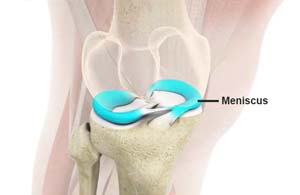
Anatomy of the Meniscus
Two wedge-shaped cartilage pieces are present between the thighbone and shinbone. These are called menisci. They stabilize the knee joint and act as shock absorbers.
What are Meniscal Tears?
A meniscus tear is the commonest knee injury in athletes, especially those involved in contact sports. A sudden bend or twist in your knee can cause the meniscus to tear. This is a traumatic meniscal tear. The elderly are more prone to degenerative meniscal tears as the cartilage wears out and weakens with age.
Symptoms of Meniscal Tears
A torn meniscus causes pain, swelling, stiffness, catching or locking sensation in your knee, making you unable to move your knee through its complete range of motion.
Diagnosis of Meniscal Tears
Your orthopedic surgeon will examine your knee, evaluate your symptoms and medical history before suggesting a treatment plan.
Treatment of Meniscal Tears
The treatment of a meniscal tear depends on the type, size, and location of the tear, as well as your age and activity level. If the tear is small, with damage limited to the outer edge of the meniscus, non-surgical treatment may be sufficient. However, if the symptoms do not resolve with non-surgical treatment, surgical treatment may be recommended.
Surgical Treatment of Meniscal Tears
Knee arthroscopy is the commonly recommended surgical procedure for meniscal tears. The surgical treatment options include:
- Meniscus removal (meniscectomy)
- Meniscus repair
- Meniscus replacement
Surgery can be performed using arthroscopy where a small camera will be inserted through a small incision, which enables your surgeon to view the inside of your knee on a large screen.
The surgery will be performed through other small incisions. During meniscectomy, small instruments called shavers or scissors may be used to remove the torn meniscus.
In arthroscopic meniscus repair, the torn meniscus will be pinned or sutured depending on the extent of the tear.
Meniscus replacement or transplantation involves the replacement of a torn cartilage with the cartilage obtained from a donor or a cultured patch obtained from the laboratory. It is considered as a treatment option to relieve knee pain if you have undergone meniscectomy.
Related Topics:
- Knee Arthroscopy
- ACL Reconstruction
- Multiligament Reconstruction of the Knee
- Meniscal Surgery
- Cartilage Restoration
- Orthobiologics
- ACL Reconstruction with Patellar Tendon
- Partial Arthroscopic Meniscectomy
- Saucerization
- Intraarticluar Knee Injection
- Knee Fracture Surgery
- Arthroscopic Debridement
- LPFL Reconstruction
- Tibial Derotational Osteotomy
- Failed Meniscus Repair
- Meniscal Transplantation
- Meniscectomy
- Mosaicplasty
- Posterolateral Corner Reconstruction
- Prior Meniscectomy
- Quadriceps Tendon Repair
- Tibial Eminence Fracture
- Trochleoplasty
- ORIF of the Knee Fracture
- Chondroplasty
- Distal Femoral Osteotomy
- Hamstring Autograft
- Hamstring Allograft
- Viscosupplementation
- Physical Therapy for Knee
- Knee Osteoarthritis
- High Tibial Osteotomy
- Tibial Tubercle Osteotomy
- Patellar Tendon Repair
- Robotic Assisted Partial Knee Surgery
- Distal Realignment Procedures
- PCL Reconstruction
- LCL Reconstruction
- MCL Reconstruction
- Cartilage Replacement
- Bicompartmental Knee Resurfacing
- Autologous Chondrocyte Implantation
- Subchondroplasty
- Partial Meniscectomy
- Transphyseal Surgery
- Partial Transphyseal Surgery
- Medial Patellofemoral Ligament Reconstruction
- ACL Reconstruction Procedure with Hamstring Tendon
- Physeal Sparing Surgery (Anderson's Technique)
- Physeal Sparing Surgery (Micheli-KocherTechnique)
- Combined Hyaluronic Therapy for the Knee
- Matrix Induced Autologous Chondrocyte Implantation (MACI)
- Failed Anterior Cruciate Ligament (ACL) Reconstruction
- Physeal Sparing Reconstruction of the Anterior Cruciate Ligament
- Bone-Patellar Tendon-Bone (BPTB) Autograft
- Bone-Patellar Tendon-Bone (BPTB) Allograft
- Pharmacological Interventions for Knee Injuries
- Arthroscopic Reconstruction of the Knee for Ligament Injuries

